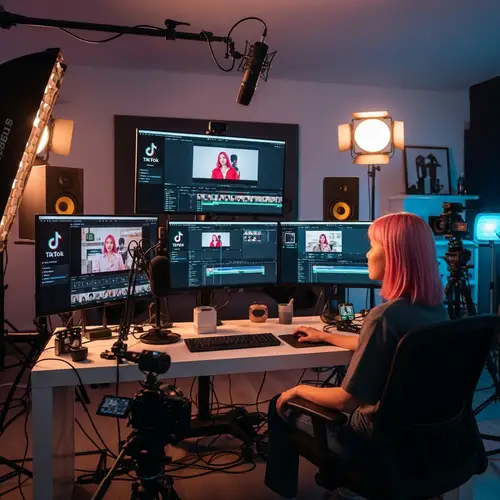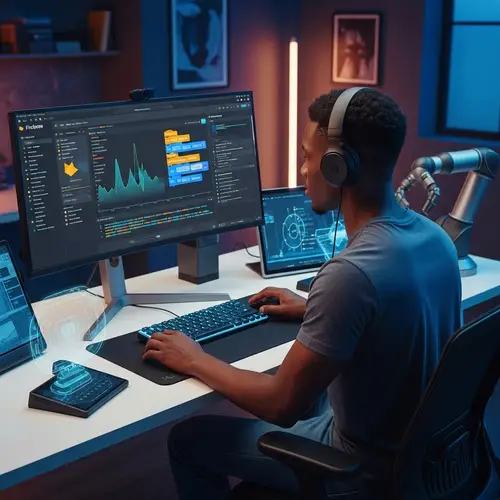TikTok AI tools has been shaking things up in the world of advertising, to say the least. Their newest rollout is packed with AI-powered instruments that promise to make ad creation a whole lot easier—and if you ask me, a bit more exciting too. Simply put, TikTok wants to help advertisers build video ads faster, slicker, and with way less effort.
From transforming text into full-blown video content to generating digital avatars that can represent your brand, these new tools feel kinda like a filmmaker’s playground, all powered by advanced calculations. What exactly makes each tool tick? And more importantly, how can you actually use them to hit those campaign targets without pulling your hair out?
Let’s walk through what’s new, what makes it special, and how you can make the most of it.
Presentation to TikTok AI Video Tools for Advertisers

This new mix of AI instruments from TikTok is designed to help marketers produce more content without needing a full studio crew. We’re talking quick image-to-video transformations, talking avatars, and AI-generated voiceovers that sound anything but robotic.
If your brain’s buzzing with questions like “How do I use TikTok’s image to video tool?” or “Is their AI avatar actually convincing?”, well… you’re definitely not the only one. So let’s break them down one by one.
Image-to-Video Generator
The image-to-video instrument allows brands to upload a still image and have TikTok’s AI practically animate it into motion. You end up with a full video, complete with motion effects and relevant music suggestions.
I could be wrong, but this tool hits home for smaller teams trying to stretch a limited catalog into a full campaign. Upload your product shot, point the AI in a general direction (think vibe, style, mood), and you’ll have something scroll-stopping within minutes.
It’s especially helpful for eCommerce stores or brands that don’t have teams of videographers at the ready. And in my opinion, it’s nifty without requiring too many bells and whistles just to get a decent result.
Text-to-Video Ad Creator
With this feature, you can type out just a few lines of script, and TikTok will generate an ad video from it. It chooses visuals, transitions, captions, and music based on what you’ve written.
Honestly, I feel like this tool is for those days when your creative energy is running on fumes. You input some bullet points or a short product description, and out pops a working draft of a video ad. You don’t have to use it as-is, of course. But it’s a solid starting point—like a rough sketch that guides your final edit.
What precisely sets this feature apart from the swarm of other AI tools? It adapts to TikTok’s own content style, which, let’s be real, is a rhythm that’s constantly changing. You won’t get a bland slideshow-style video. The output usually matches the fast cuts and vibrant energy TikTok audiences expect.
AI Avatar Product Showcase
Now here’s where things get kind of wild. This feature lets you create a digital avatar to act as a spokesperson for your video ad. It uses real human models combined with AI-generated expressions and voice-overs.
Maybe it’s just me, but I kinda get the vibe that companies are going to lean into this big time. It solves the whole “we don’t have influencers on hand” issue in a surprisingly realistic way. Want a female avatar explaining your skincare item in Spanish? There’s an option for that.
The way I see it, this could especially help global brands. You can localize content without casting a new face in every country. And that’s not just efficient—it can seriously scale a campaign across languages fast.
How to Use TikTok’s AI Video Tools Effectively

Let’s go beyond the surface. Using these instruments isn’t much of a tech hurdle, even if your background is more marketing than machine learning.
Getting Started
First, head into your TikTok Ads Manager dashboard. You’ll find access to Creative Center, which houses features like the image-to-video and text-to-video systems.
From there, you can either start from an existing ad or drop in new creative prompts, like an image file or a few lines of text description. The process is mostly drag-and-drop, although you will want to preview a few versions before hitting publish, obviously.
Voice and Language Settings
The AI avatars come with customization options. Want a deeper voice? Slower delivery? That’s there. You can even pick different accents to match your audience’s region. Not gonna lie, that level of flexibility is a big win for brands trying to sound more genuine to their viewers.
Syncing Content with Predictive Dialing and CRM Tools
If your company is already using predictive dialing or CRM integration instruments, TikTok’s content generation features can align nicely with those systems. While TikTok hasn’t exactly created CRM-specific bridges yet, scheduled ad drops and remarketing sequences play well with most external platforms. You just need to keep timing and message alignment in mind when plugging in your AI repped videos.
So, What Makes This Launch a Big Deal?

Here’s the honest scoop—TikTok’s AI push isn’t just about helping marketers move faster. It’s about keeping pace with how people are watching, buying, and interacting online.
Everything’s happening faster, expectations are higher, and content fatigue is real. I mean, how many times have you scrolled past an ad within half a second? These instruments aim to patch that closing window of attention with videos that are sharper, targeted, and faster to produce.
Also, and this might sound weird, but having talking head avatars sell products might actually improve ad completion rates just because the novelty makes people stick around a second longer. That second could be all you need.
What’s Coming Next (Or What We’d Like to See)

Although TikTok hasn’t dropped the full roadmap, people in the space are hoping for some additions. Like avatar lip sync matching that’s more polished, AR features layered directly into video scenes, or AI predictive tweaks based on your prior post performance.
Personally, I’d like to see better suggestion models that pull product descriptions dynamically from your online store feed or CRM notes. Why click copy-paste when AI can do that legwork?
FAQs: TikTok AI Video Tools
Yes, you can. These tools are super simple—upload an image, write some text, or choose an avatar, and let the AI do the rest. You’ll still want to preview and maybe tweak the results before going live, but no advanced editing is required.
Surprisingly convincing. They’re not deepfakes per se, but they’re close enough to pass for a human if you’re not zooming in. Voiceovers are better than what you’d hear from older TTS models.
Big time. It cuts down content creation time and cost. Smaller teams can now publish more professional ads without hiring video teams or influencers.
Yep. While TikTok’s tools live inside their system, you can download the videos and use them elsewhere, or schedule them using CRM integrations.
Nope, they’re included in TikTok’s Creative Center for existing ad accounts. You don’t have to pay more to access the AI systems.
Wrapping Up

For what it’s worth, TikTok’s AI video tools are a pretty smart step toward making marketing more manageable. They’re not perfect, and obviously there’s still a place for full production teams—but when you’re balancing speed, cost, and quality, these instruments are worth plugging into your strategy.
The way I see it, whether you’re a startup looking to punch above your weight or an established brand trying to refresh your strategy, there’s something practical in each of these instruments. You might not need them all today, but keeping them in your toolkit isn’t a bad move.
Curious about what else AI can whip up for your marketing campaigns? Take a moment to explore the questions you could be asking next—not just to TikTok’s tools, but maybe to AI platforms like Claude AI or even those predictive CRM bots.
TikTok AI Video Tools for Advertisers: Create Image, Text & Avatar Ads Easily
Want to see how these AI-powered tools fit your campaign goals? Dive in and start testing out TikTok’s Creative Center today. And hey—don’t keep the insights to yourself. Share this article with fellow marketers and let’s build smarter strategies, together.




